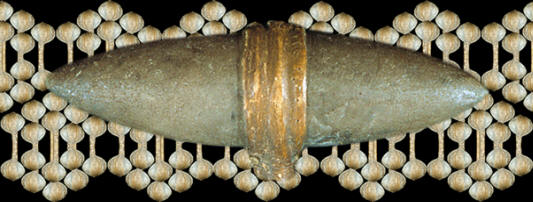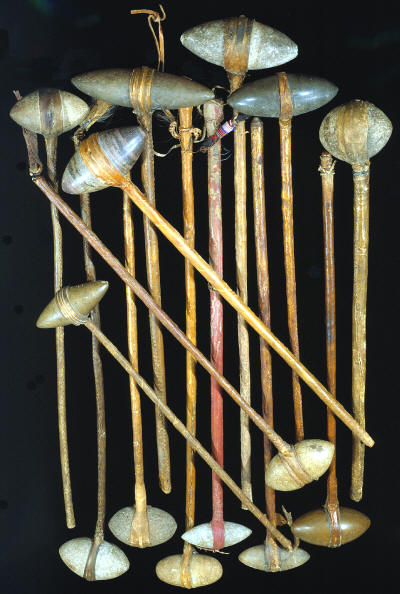|
|
|
Some club heads were carefully shaped by pecking and grinding. The surfaces were pecked into shape with a hammerstone then smoothed by grinding the surface with another stone. Other club heads did not receive as much attention. These more simpler examples were made of natural pebbles that were only slightly altered by pecking a narrow groove around the center that held the rawhide hafting material into place. Still other club head stones were simply covered entirely in rawhide. They had little or no alteration to their natural form. |
|
|
Plains Indian warriors made their clubs with basic traditional techniques but often added individualized variations to the design. Thomas Mails writes in "The Mystic Warriors of the Plains" that "the warriors were producing clubs in great variety, with each man fashioning his according to visions or fancy." By 1800 the plains Indians were making a wide variety of clubs. Some were skillfully quilled, with quills that covered both the handle and the head. Other clubs were covered in mink and beads. Symbolic lines were also sometimes painted on the head straps. |
|
|
There were three main styles of plains Indian stone-headed war clubs. One type, called the slingshot variety, wrapped the stone in rawhide and was mounted onto the handle in a way that allowed two or three inches of flexible leather between the stone and handle. This design allowed the stone to swing with a greater force upon the body of an enemy. Another style encased a round stone and the handle in rawhide without the flexible action of the slingshot. The other design can be seen in the illustrations of this report. These clubs are hafted with double pointed stones to long handles with a leather hafting strap around grooved and ungrooved stones. |
|
|
|
|
Most clubs were made for warfare. They were used in hand-to-hand combat on the ground and from the backs of horses. They were objects of pride. It's said that some war clubs were treated with great reverence by their owners. The degree of craftsmanship, as seen in many fine examples in modern day collections, reflect these ideas. The horse culture tribes of the western plains were once invincible over their prairie domain. The plains Indian war club was a formidable weapon but, as a Stone Age tool, it was almost worthless in modern warfare. |
|
|
"REFERENCES"
1912,
Hodge, Frederick Webb "Handbook of American Indians North of Mexico,"
part 1, p. 313. |
|



